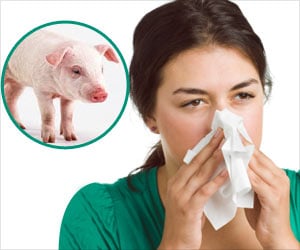WHAT IS IT? Swine flu is the name commonly given to a new form of flu. From a first known case in Mexico, the outbreak has spread at exceptional speed, prompting the UN's World
What is it?
"Swine flu" is the name commonly given to a new form of flu. From a first known case in Mexico, the outbreak has spread at exceptional speed, prompting the UN's World Health Organisation (WHO) to declare a pandemic on June 11. The official designation is A(H1N1) influenza.Why the alarm?
People have no or little immunity against the new virus. Three times in the past century, brand-new flu strains have spread around the world, killing millions of people. The good news is that A(H1N1) is contagious but relatively mild. Its effects are comparable to those of ordinary, or "seasonal", flu. But the worry is that it could pick up genes making it as lethal as past pandemic microbes.
What is the toll?
More than 700 people have been killed by A(H1N1), according to the WHO. It stopped issuing a tally of infections in July, when recorded cases neared the 100,000 mark. By comparison, between 250,000 to 500,000 people around the world die of regular seasonal flu every year.
How does A(H1N1) spread?
Advertisements
What are the symptoms?
Advertisements
When should I seek help?
Medical care should be sought if you suffer shortness of breath or difficulty breathing, if a fever persists beyond three days, or if you also have a condition that could cause complications, such as pregnancy or an underlying respiratory disorder. Parents should seek help if a young child has fast or laboured breathing, continuing fever or seizures.
How is swine flu treated?
At home, someone with flu can be helped by letting them rest, drink plenty of fluids and take a pain reliever for aches. A non-aspirin pain reliever should be used by children and young adults because of the risk of a rare but serious disorder called Reye's syndrome. Doctors may also prescribe oseltamivir, marketed as Tamiflu, or zanamivir, marketed as Relenza. These work by preventing the virus from reproducing. If administered in time, they can ease symptoms, shorten the duration of illness and reduce infectiousness for others. Many governments have built up a stockpile of these antivirals as part of their anti-pandemic strategy.
Is there a vaccine?
Trials are underway among volunteers to see if a candidate vaccine is safe and invokes an effective response against the virus by the immune system. If all goes well, the vaccine should be available in the northern hemisphere's autumn, although the precise date is unclear. It remains uncertain whether the vaccine will still provide a shield if the novel flu mutates further.
How can I avoid infection?
Commonsense hygiene and social distancing reduce the risk. They include frequent hand-washing using soap or alcohol-based gel; covering one's face while sneezing or coughing; and using clean paper handkerchiefs that are carefully disposed of after use. You can also avoid greeting someone with a kiss or a handshake; clean commonly-touched surfaces such as telephones, computer keyboards, door handles, tables and lift buttons; and keep good ventilation in your home or workplace. A distance of two metres (six feet) from an infected person also reduces the contagion risk, as can a face mask, if properly used (paper or cloth masks must be changed every four hours). If you fall sick, stay at home if possible to avoid infecting others.
Should I go to a swine flu party?
No, say watchdogs. "Swine flu parties" are gatherings where people deliberately come into close contact with someone with A(H1N1) in order to become infected with the virus. Their hope is that by being exposed to a mild form of flu, they will gain immunity against a more severe form in future. Health experts caution against these "parties". Even if swine flu is relatively mild, some cases have been severe and even been fatal. In addition, you may unwittingly transmit the virus to someone elderly or with respiratory problems, and place them at risk. And there is no guarantee that being infected now will protect you later, if the virus does mutate.
Why "Swine Flu"?
The early suspicions were that the reassorted virus leapt from pigs to humans. But the virus' genetic signature points to a variety of sources from humans, birds and pigs, and the origin remains unknown. There is no evidence that anyone has picked up A(H1N1) from pigs or any other animal.
What does A(H1N1) mean?
The "A" denotes one of the A group of influenza viruses. A and B viruses can cause seasonal flu, but only A viruses have caused flu pandemics. There is also a C viral group blamed for sporadic cases of flu. The "H" and "N" refer to two viral proteins, haemagglutinin and neuraminidase. The two "1s" relate to the subtype of protein structure, which varies significantly.
Sources: WHO, the US Centers for Disease Control and Prevention (CDC), European Centre for Disease Prevention and Control (ECDC), French ministry of health.
Source-AFP
SRM









